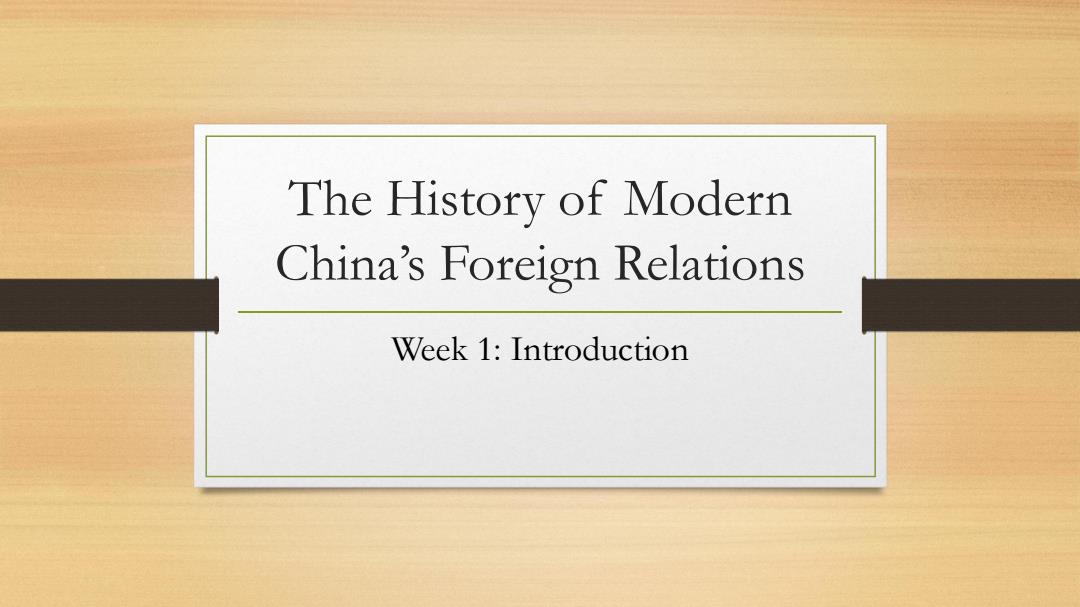
The History of Modern China's Foreign Relations Week 1:Introduction
The History of Modern China’s Foreign Relations Week 1: Introduction
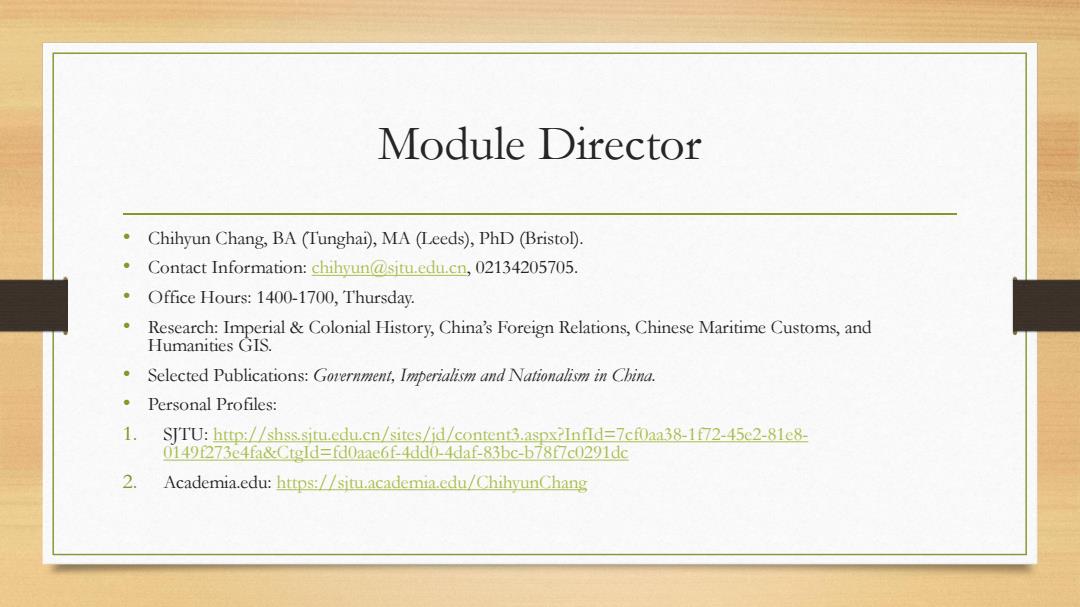
Module Director Chihyun Chang,BA (Tunghai),MA (Leeds),PhD (Bristol). Contact Information:chihyun @situ.edu.cn,02134205705. .Office Hours:1400-1700,Thursday. 。 Research:Imperial Colonial History,China's Foreign Relations,Chinese Maritime Customs,and Humanities GIS. .Selected Publications:Government,Imperialism and Nationalism in China. 。 Personal Profiles: 1. SITU:http://shss.situ.edu.cn/sites/id/content3.aspx?Infld=7cf0aa38-1f72-45e2-81e8- 0149f273e4fa&Ctgld=fdoaae6f-4dd0-4daf-83bc-b78f7c0291dc 2. Academia.edu:https://sit.academia.cdu/ChihyunChang
Module Director • Chihyun Chang, BA (Tunghai), MA (Leeds), PhD (Bristol). • Contact Information: chihyun@sjtu.edu.cn, 02134205705. • Office Hours: 1400-1700, Thursday. • Research: Imperial & Colonial History, China’s Foreign Relations, Chinese Maritime Customs, and Humanities GIS. • Selected Publications: Government, Imperialism and Nationalism in China. • Personal Profiles: 1. SJTU: http://shss.sjtu.edu.cn/sites/jd/content3.aspx?InfId=7cf0aa38-1f72-45e2-81e8- 0149f273e4fa&CtgId=fd0aae6f-4dd0-4daf-83bc-b78f7c0291dc 2. Academia.edu: https://sjtu.academia.edu/ChihyunChang
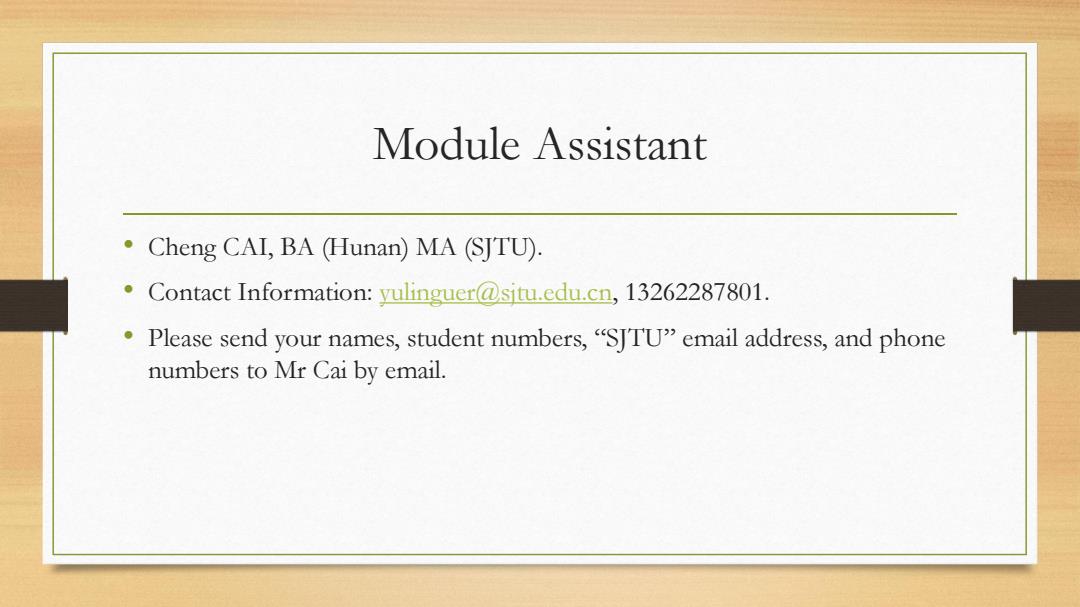
Module Assistant Cheng CAI,BA (Hunan)MA(SJTU) Contact Information:yulinguer @situ.edu.cn,13262287801. Please send your names,student numbers,"SJTU"email address,and phone numbers to Mr Cai by email
Module Assistant • Cheng CAI, BA (Hunan) MA (SJTU). • Contact Information: yulinguer@sjtu.edu.cn, 13262287801. • Please send your names, student numbers, “SJTU” email address, and phone numbers to Mr Cai by email
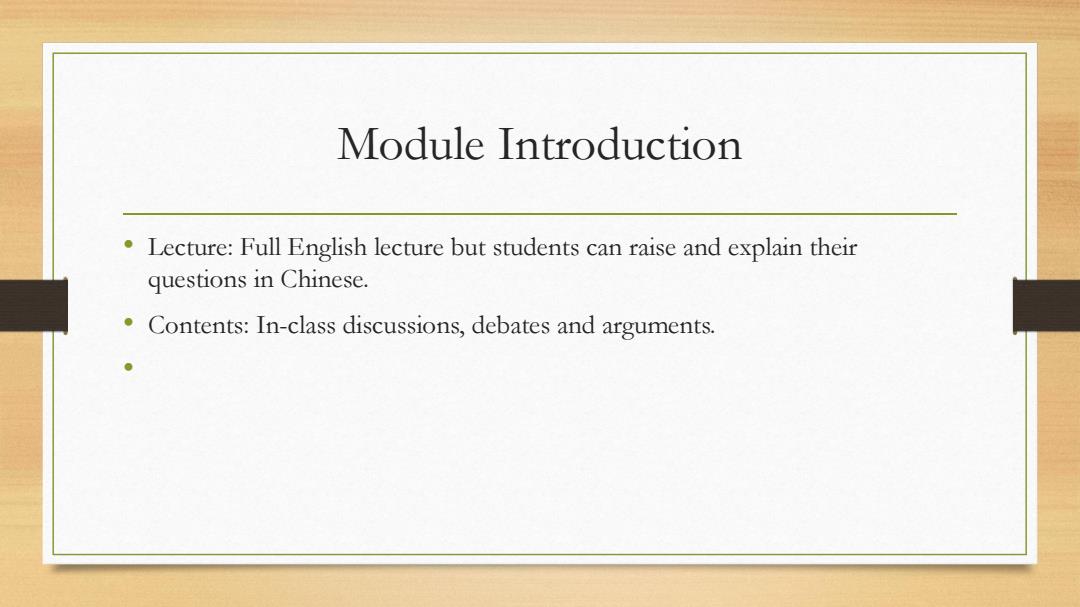
Module Introduction Lecture:Full English lecture but students can raise and explain their questions in Chinese. 。 Contents:In-class discussions,debates and arguments
Module Introduction • Lecture: Full English lecture but students can raise and explain their questions in Chinese. • Contents: In-class discussions, debates and arguments. •
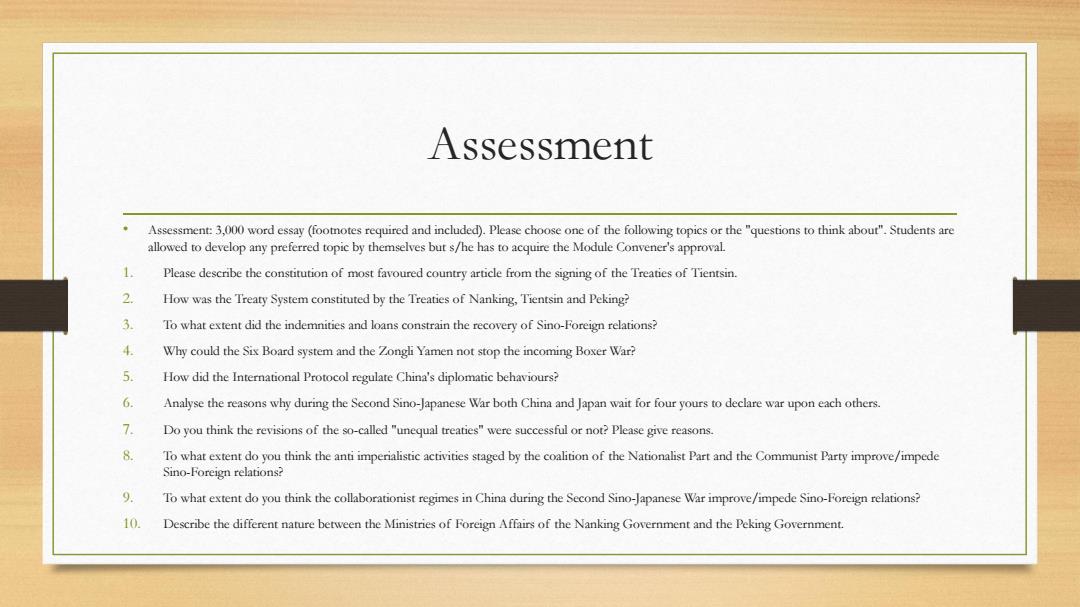
Assessment Assessment:3,000 word essay(foomotes required and included).Please choose one of the following topics or the"questions to think about".Students are allowed to develop any preferred topic by themselves but s/he has to acquire the Module Convener's approval 1 Please describe the constitution of most favoured country article from the signing of the Treaties of Tientsin. 2. How was the Treaty System constituted by the Treaties of Nanking,Tientsin and Peking? 3. To what extent did the indemnities and loans constrain the recovery of Sino-Foreign relations? 4. Why could the Six Board system and the Zongli Yamen not stop the incoming Boxer War? 5. How did the International Protocol regulate China's diplomatic behaviours? 6 Analyse the reasons why during the Second Sino-Japanese War both China and Japan wait for four yours to declare war upon each others. 7. Do you think the revisions of the so-called"unequal treaties"were successful or not?Please give reasons. 8. To what extent do you think the anti imperialistic activities staged by the coalition of the Nationalist Part and the Communist Party improve/impede Sino-Foreign relations? 9. To what extent do you think the collaborationist regimes in China during the Second Sino-Japanese War improve/impede Sino-Foreign relations? 10. Describe the different nature between the Ministries of Foreign Affairs of the Nanking Government and the Peking Government
Assessment • Assessment: 3,000 word essay (footnotes required and included). Please choose one of the following topics or the "questions to think about". Students are allowed to develop any preferred topic by themselves but s/he has to acquire the Module Convener's approval. 1. Please describe the constitution of most favoured country article from the signing of the Treaties of Tientsin. 2. How was the Treaty System constituted by the Treaties of Nanking, Tientsin and Peking? 3. To what extent did the indemnities and loans constrain the recovery of Sino-Foreign relations? 4. Why could the Six Board system and the Zongli Yamen not stop the incoming Boxer War? 5. How did the International Protocol regulate China's diplomatic behaviours? 6. Analyse the reasons why during the Second Sino-Japanese War both China and Japan wait for four yours to declare war upon each others. 7. Do you think the revisions of the so-called "unequal treaties" were successful or not? Please give reasons. 8. To what extent do you think the anti imperialistic activities staged by the coalition of the Nationalist Part and the Communist Party improve/impede Sino-Foreign relations? 9. To what extent do you think the collaborationist regimes in China during the Second Sino-Japanese War improve/impede Sino-Foreign relations? 10. Describe the different nature between the Ministries of Foreign Affairs of the Nanking Government and the Peking Government

Plagiarism(④ 。 Plagiarism is strictly prohibited.Any incidence of this will lead to serious consequences, namely the definite fail of this module and every case will be reported to the his/her affiliated School. The contents are summarised from"What is Plagiarism").Students should surf the website "What is Plagiarism"(wwwplagiarismorg)and have a basic idea about plagiarism. .Hence,students are more than welcome to discuss all sentences from their assignments which might be involved in plagiarism
Plagiarism (I) • Plagiarism is strictly prohibited. Any incidence of this will lead to serious consequences, namely the definite fail of this module and every case will be reported to the his/her affiliated School. • The contents are summarised from "What is Plagiarism"). Students should surf the website "What is Plagiarism" (www.plagiarism.org) and have a basic idea about plagiarism. • Hence, students are more than welcome to discuss all sentences from their assignments which might be involved in plagiarism

Plagiarism ID) Definitions of plagiarism: to steal and pass off(the ideas or words of another)as one's own; to use(another's production)without crediting the source; to commit literary theft;and to present as new and original an idea or product derived from an existing source. PLAGIARISM IS AN ACT OF FRAUD! IT INVOLVES BOTH STEALING SOMEONE ELSE'S WORK AND LYING ABOUT IT AFTERWARD
Plagiarism (II) Definitions of plagiarism: • to steal and pass off (the ideas or words of another) as one’s own; • to use (another's production) without crediting the source; • to commit literary theft; and • to present as new and original an idea or product derived from an existing source. PLAGIARISM IS AN ACT OF FRAUD! IT INVOLVES BOTH STEALING SOMEONE ELSE'S WORK AND LYING ABOUT IT AFTERWARD
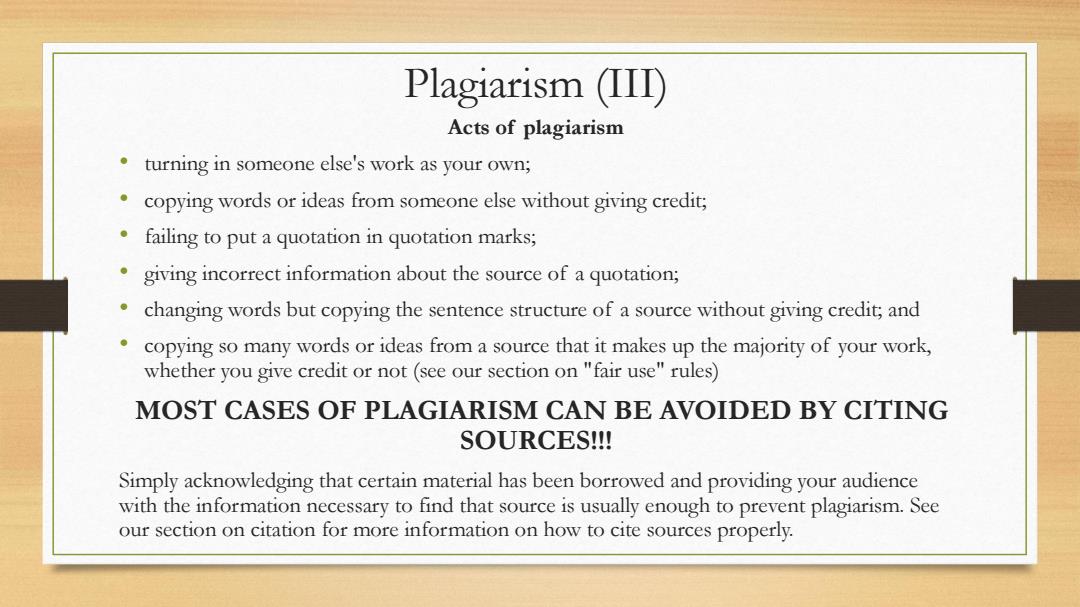
Plagiarism (IIT) Acts of plagiarism turning in someone else's work as your own; copying words or ideas from someone else without giving credit; failing to put a quotation in quotation marks; giving incorrect information about the source of a quotation; changing words but copying the sentence structure of a source without giving credit;and copying so many words or ideas from a source that it makes up the majority of your work, whether you give credit or not(see our section on"fair use"rules) MOST CASES OF PLAGIARISM CAN BE AVOIDED BY CITING SOURCES!!! Simply acknowledging that certain material has been borrowed and providing your audience with the information necessary to find that source is usually enough to prevent plagiarism.See our section on citation for more information on how to cite sources properly
Plagiarism (III) Acts of plagiarism • turning in someone else's work as your own; • copying words or ideas from someone else without giving credit; • failing to put a quotation in quotation marks; • giving incorrect information about the source of a quotation; • changing words but copying the sentence structure of a source without giving credit; and • copying so many words or ideas from a source that it makes up the majority of your work, whether you give credit or not (see our section on "fair use" rules) MOST CASES OF PLAGIARISM CAN BE AVOIDED BY CITING SOURCES!!! Simply acknowledging that certain material has been borrowed and providing your audience with the information necessary to find that source is usually enough to prevent plagiarism. See our section on citation for more information on how to cite sources properly

Plagiarism (IV) Types of plagiarism: 1.Submitting another's work,word-for-word,as one's own; 2. Contains significant portions of text from a single source without alterations; 3. Changing key words and phrases but retaining the essential content of the source; 4. Paraphrases from multiple sources,made to fit together; 5. Borrows generously from the writer's previous work without citation; 6. Combines perfectly cited sources with copied passages without citation; 7. Mixes copied material from multiple sources; 8. Includes citations to non-existent or inaccurate information about sources; 9. Includes proper citation to sources but the paper contains almost no original work; 10.Includes proper citation,but relies too closely on the text's original wording and/or structure. Plagiarism is not always a black and white issue. Learning to recognise the various forms of plagiarism,especially the more ambiguous ones,is an important step towards effective prevention
Types of plagiarism: 1. Submitting another’s work, word-for-word, as one’s own; 2. Contains significant portions of text from a single source without alterations; 3. Changing key words and phrases but retaining the essential content of the source; 4. Paraphrases from multiple sources, made to fit together; 5. Borrows generously from the writer’s previous work without citation; 6. Combines perfectly cited sources with copied passages without citation; 7. Mixes copied material from multiple sources; 8. Includes citations to non-existent or inaccurate information about sources; 9. Includes proper citation to sources but the paper contains almost no original work; 10. Includes proper citation, but relies too closely on the text’s original wording and/or structure. Plagiarism is not always a black and white issue. Learning to recognise the various forms of plagiarism, especially the more ambiguous ones, is an important step towards effective prevention. Plagiarism (IV)
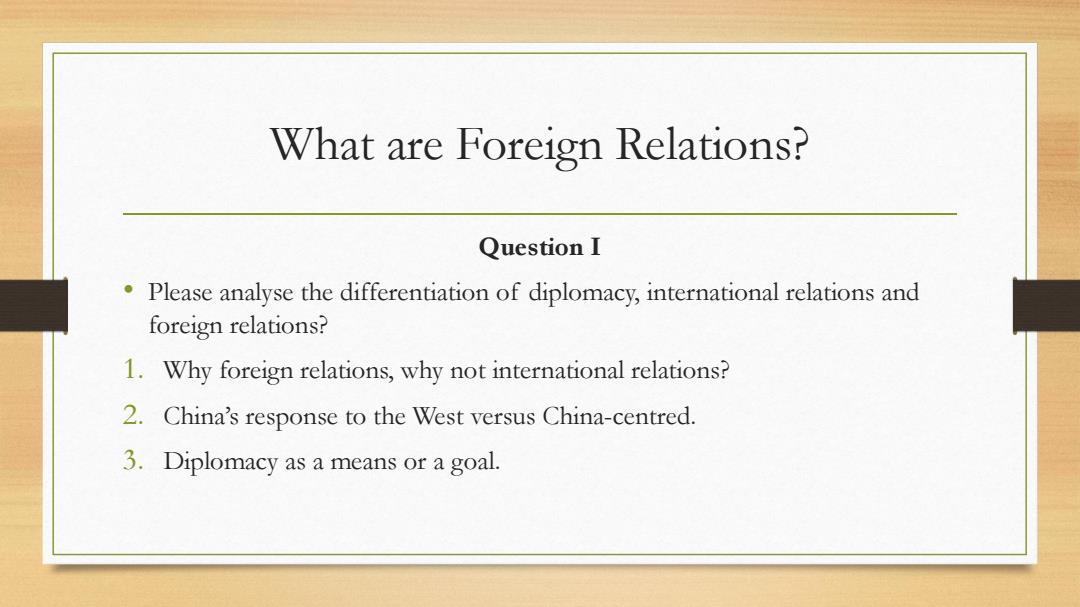
What are Foreign Relations? Question I Please analyse the differentiation of diplomacy,international relations and foreign relations? 1.Why foreign relations,why not international relations? 2.China's response to the West versus China-centred. 3.Diplomacy as a means or a goal
What are Foreign Relations? Question I • Please analyse the differentiation of diplomacy, international relations and foreign relations? 1. Why foreign relations, why not international relations? 2. China’s response to the West versus China-centred. 3. Diplomacy as a means or a goal